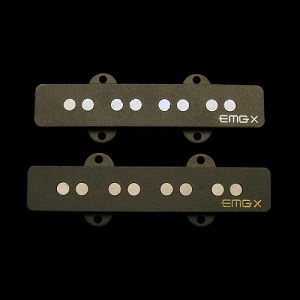Review: EMG JVX Pickup Set Does Fender Better than Leo
(ShackMan | Posted 2010-12-21)

It's not often that I get into the studio with a new product, either through this website or my own adventures, that so thoroughly impresses me that it actually changes the way I think about and/or play the instrument. Something that just makes my instrument speak to me in a way I'd never heard before and consequently leaves me feeling "enabled," in a sense. It's not an easy thing to force into just one word, but it's left me feeling like I can do more with my bass, like I have more headroom not just in volume, but for my talent and my voice to come through. Yeah, I realize I'm putting the verdict up front, but it's a little late for a spoiler alert now, isn't it? So sure, if you're here for nothing more than a recommendation and you're standing there holding a Jazz Bass or something with J-style pickups that you think could use a little pick-me-up (and frankly, after the mid-90s a lot of Fender's axes can), then you've got it. Now, if you'd like to know why, read on.
I'm sure everyone knows about EMG's guitar side and its metal edge. Kirk Hammett, Zakk Wylde, Jeff Loomis, Alexi Laiho, and hundreds of others make up a laundry list of players who crave their humbuckers and their sensitive, high-gain edge, so it was with some curiosity that I tried out the JVX set. I only say "some" curiosity because I already had an idea what they sounded like, having been introduced to them through Victor Wooten and playing his bass at the Summer NAMM convention. So I was curious as to how these were made to sound like a vintage jazz bass. My only solution was to swap my noiseless pickups of my Fender Jazz and throw the JVX's in.
The swap-in and swap-out process was a breeze. I'm not technical wizard, but EMG did a great job of making sure there were next to no loose parts or screws in the setup process - only modular connectors that slipped right on. It even came with a 9V battery "snuggie" (Ed Friedland's term, not mine) for shielding. I was able to fit everything in quite nicely with no adjustments necessary. Directions were well-written and clearly explained with color pictures for every step. Necessary tools were basic, including a screwdriver and occasionally a pair of pliers. The worst you could have to do is round out the body cavity for the bridge pickup or file in a little extra room for the battery. Overall, setup took me right around two hours, but I was going slow to make sure I made no mistakes.
That done, I proceeded to plug in and play away. My most immediate feeling was that my bass must have felt or sounded dull before this, because what was now coming out of my amplifier was so much more focused with a finely sharpened attack. I still could feel and hear the warm roundness of a vintage jazz bass, but with a more driving edge that reminded me of what EMG is known for. These aren't high gain pickups, but they were so pristinely clean that they almost felt like a high gain set.
All of the expected tones were here, from burpy fingerstyle funk from the bridge pickup, up to a blended slap-style from both pickups, all the way to deep dub tones from the neck pickup, made possible by a very wide tone control. Blending and soloing the pickups didn't produce any noise, either - another of EMG's trademarks, and one they're surprisingly successful at even with tough single coil pickups. The tone control frequency roll-off was well-designed, and unlike many tone controls, I found several different tones that I liked at various positions on the tone control, rather than simply full-on, full-off and part-way. I'd never quite thought about those tonal possibilities until just then, but playing with it made me almost forget that they hadn't been there in the first place.
Sustain was surprisingly long for a pickup with pole pieces instead of a bar magnet, where the pull on the string is considerably weaker, but it was still less than other EMG pickups have had. This, as I said, is the nature of pickups with pole pieces, and not a design flaw. It was also the nature of the old J-basses, so I felt strangely at home there as well.
These elements combined together to leave me with a resounding feeling that EMG really had managed to combine modern accoutrements (the extended tone controls, modular connectors, sharpened attack and bright high-end) with a vintage sound (rounded sustained tone, booming lows), and being able to have what felt like the best of both worlds at once really inspired me to look at and hear my bass in new and inspiring ways. On behalf of myself and MGR, I declare these pickups as close to the perfect bass tone as I have yet heard. Victor Wooten was right to put these in, and they'll be staying in my bass, I wager, for a very long time. Thanks, EMG.
James Rushin is a bassist, keyboardist, writer, and composer living and working in the Greater Pittsburgh area. He has performed with Selmer artist Tim Price, Curtis Johnson, guitarists Ken Karsh and Joe Negri. His compositions have been featured at West Virginia University and Valley Forge Christian College. He will be spending the Fall and Winter months working on playwright Frank Gagliano's Voodoo Trilogy and Bodoni County Songbook, as well as a full-length album with his latest project, Shutterdown.
He also unofficially endorses EMG Pickups (starting now) and Nord Keyboards, because they're the best.
Got questions? Comments? Is there something you'd like to see covered better in this article? James can be reached as ShackMan in the Music Gear Review forums, or you may e-mail him at James.Rushin@MusicGearReview.com.



